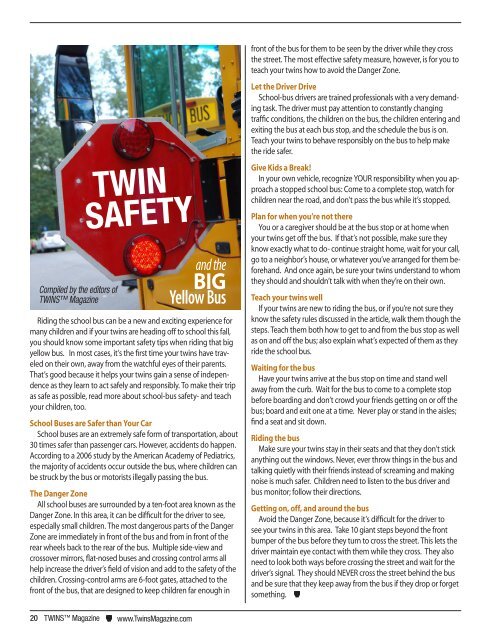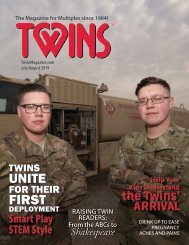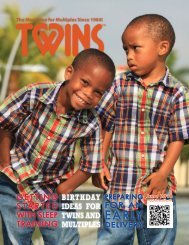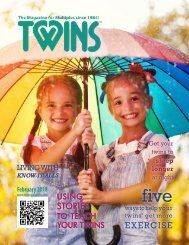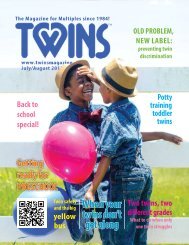2014JulAug
You also want an ePaper? Increase the reach of your titles
YUMPU automatically turns print PDFs into web optimized ePapers that Google loves.
Compiled by the editors of<br />
TWINS Magazine<br />
TWIN<br />
SAFETY<br />
and the<br />
BIG<br />
Yellow Bus<br />
Riding the school bus can be a new and exciting experience for<br />
many children and if your twins are heading off to school this fall,<br />
you should know some important safety tips when riding that big<br />
yellow bus. In most cases, it’s the first time your twins have traveled<br />
on their own, away from the watchful eyes of their parents.<br />
That’s good because it helps your twins gain a sense of independence<br />
as they learn to act safely and responsibly. To make their trip<br />
as safe as possible, read more about school-bus safety- and teach<br />
your children, too.<br />
School Buses are Safer than Your Car<br />
School buses are an extremely safe form of transportation, about<br />
30 times safer than passenger cars. However, accidents do happen.<br />
According to a 2006 study by the American Academy of Pediatrics,<br />
the majority of accidents occur outside the bus, where children can<br />
be struck by the bus or motorists illegally passing the bus.<br />
The Danger Zone<br />
All school buses are surrounded by a ten-foot area known as the<br />
Danger Zone. In this area, it can be difficult for the driver to see,<br />
especially small children. The most dangerous parts of the Danger<br />
Zone are immediately in front of the bus and from in front of the<br />
rear wheels back to the rear of the bus. Multiple side-view and<br />
crossover mirrors, flat-nosed buses and crossing control arms all<br />
help increase the driver’s field of vision and add to the safety of the<br />
children. Crossing-control arms are 6-foot gates, attached to the<br />
front of the bus, that are designed to keep children far enough in<br />
front of the bus for them to be seen by the driver while they cross<br />
the street. The most effective safety measure, however, is for you to<br />
teach your twins how to avoid the Danger Zone.<br />
Let the Driver Drive<br />
School-bus drivers are trained professionals with a very demanding<br />
task. The driver must pay attention to constantly changing<br />
traffic conditions, the children on the bus, the children entering and<br />
exiting the bus at each bus stop, and the schedule the bus is on.<br />
Teach your twins to behave responsibly on the bus to help make<br />
the ride safer.<br />
Give Kids a Break!<br />
In your own vehicle, recognize YOUR responsibility when you approach<br />
a stopped school bus: Come to a complete stop, watch for<br />
children near the road, and don’t pass the bus while it’s stopped.<br />
Plan for when you’re not there<br />
You or a caregiver should be at the bus stop or at home when<br />
your twins get off the bus. If that’s not possible, make sure they<br />
know exactly what to do- continue straight home, wait for your call,<br />
go to a neighbor’s house, or whatever you’ve arranged for them beforehand.<br />
And once again, be sure your twins understand to whom<br />
they should and shouldn’t talk with when they’re on their own.<br />
Teach your twins well<br />
If your twins are new to riding the bus, or if you’re not sure they<br />
know the safety rules discussed in the article, walk them though the<br />
steps. Teach them both how to get to and from the bus stop as well<br />
as on and off the bus; also explain what’s expected of them as they<br />
ride the school bus.<br />
Waiting for the bus<br />
Have your twins arrive at the bus stop on time and stand well<br />
away from the curb. Wait for the bus to come to a complete stop<br />
before boarding and don’t crowd your friends getting on or off the<br />
bus; board and exit one at a time. Never play or stand in the aisles;<br />
find a seat and sit down.<br />
Riding the bus<br />
Make sure your twins stay in their seats and that they don’t stick<br />
anything out the windows. Never, ever throw things in the bus and<br />
talking quietly with their friends instead of screaming and making<br />
noise is much safer. Children need to listen to the bus driver and<br />
bus monitor; follow their directions.<br />
Getting on, off, and around the bus<br />
Avoid the Danger Zone, because it’s difficult for the driver to<br />
see your twins in this area. Take 10 giant steps beyond the front<br />
bumper of the bus before they turn to cross the street. This lets the<br />
driver maintain eye contact with them while they cross. They also<br />
need to look both ways before crossing the street and wait for the<br />
driver’s signal. They should NEVER cross the street behind the bus<br />
and be sure that they keep away from the bus if they drop or forget<br />
something.<br />
20 TWINS Magazine www.TwinsMagazine.com


